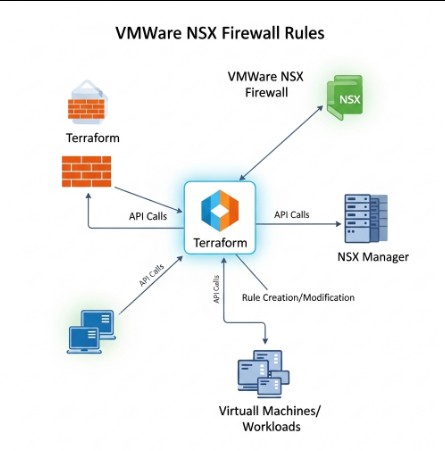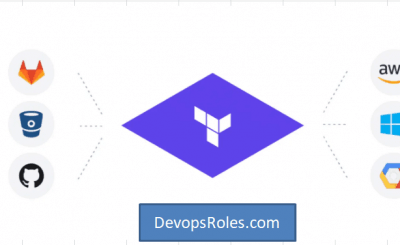Managing network security in a virtualized environment can be a complex and time-consuming task. Manually configuring firewall rules on VMware NSX, especially in large-scale deployments, is inefficient and prone to errors. This article demonstrates how to leverage terraform vmware nsx to automate the creation and management of NSX firewall rules, improving efficiency, reducing errors, and enhancing overall security posture. We’ll explore the process from basic rule creation to advanced techniques, providing practical examples and best practices.
Table of Contents
Understanding the Power of Terraform and VMware NSX
VMware NSX is a leading network virtualization platform that provides advanced security features, including distributed firewalls. Managing these firewalls manually can become overwhelming, particularly in dynamic environments with frequent changes to virtual machines and applications. Terraform, a leading Infrastructure-as-Code (IaC) tool, provides a powerful solution for automating this process. Using terraform vmware nsx allows you to define your infrastructure, including firewall rules, as code, enabling version control, repeatability, and automated deployments.
Benefits of Automating NSX Firewall Rules with Terraform
- Increased Efficiency: Automate the creation, modification, and deletion of firewall rules, eliminating manual effort.
- Reduced Errors: Minimize human error through automated deployments, ensuring consistent and accurate configurations.
- Improved Consistency: Maintain consistent firewall rules across multiple environments.
- Version Control: Track changes to firewall rules over time using Git or other version control systems.
- Enhanced Security: Implement security best practices more easily and consistently through automation.
Setting up Your Terraform Environment for VMware NSX
Before you begin, ensure you have the following prerequisites:
- A working VMware vCenter Server instance.
- A deployed VMware NSX-T Data Center instance.
- Terraform installed on your system. Download instructions can be found on the official Terraform website.
- The VMware NSX-T Terraform provider installed and configured. This typically involves configuring the `provider` block in your Terraform configuration file with your vCenter credentials and NSX manager details.
Configuring the VMware NSX Provider
A typical configuration for the VMware NSX-T provider in your `main.tf` file would look like this:
terraform {
required_providers {
vmware = {
source = "vmware/vsphere"
version = "~> 2.0"
}
nsxt = {
source = "vmware/nsxt"
version = "~> 1.0"
}
}
}
provider "vmware" {
user = "your_vcenter_username"
password = "your_vcenter_password"
vcenter_server = "your_vcenter_ip_address"
allow_unverified_ssl = false #Consider this security implication carefully!
}
provider "nsxt" {
vcenter_server = "your_vcenter_ip_address"
nsx_manager_ip = "your_nsx_manager_ip_address"
user = "your_nsx_username"
password = "your_nsx_password"
}Creating and Managing Firewall Rules with Terraform VMware NSX
Now, let’s create a simple firewall rule. We’ll define a rule that allows SSH traffic (port 22) from a specific IP address to a given virtual machine.
Defining the Firewall Rule Resource
The following Terraform code defines a basic firewall rule. Replace placeholders with your actual values.
resource "nsxt_firewall_section" "example" {
display_name = "Example Firewall Section"
description = "This section contains basic firewall rules"
}
resource "nsxt_firewall_rule" "allow_ssh" {
display_name = "Allow SSH"
description = "Allow SSH from specific IP"
section_id = nsxt_firewall_section.example.id
action = "ALLOW"
source {
groups = ["group_id"] #replace with your pre-existing source group
ip_addresses = ["192.168.1.100"]
}
destination {
groups = ["group_id"] #replace with your pre-existing destination group
virtual_machines = ["vm_id"] #replace with your virtual machine ID
}
services {
ports = ["22"]
protocols = ["TCP"]
}
}Applying the Terraform Configuration
After defining your firewall rule, apply the configuration using the command terraform apply. Terraform will create the rule in your VMware NSX environment. Always review the plan before applying any changes.
Advanced Techniques with Terraform VMware NSX
Beyond basic rule creation, Terraform offers advanced capabilities:
Managing Multiple Firewall Rules
You can define multiple firewall rules within the same Terraform configuration, allowing for comprehensive management of your NSX firewall policies.
Dynamically Generating Firewall Rules
For large-scale deployments, you can dynamically generate firewall rules using data sources and loops, allowing you to manage hundreds or even thousands of rules efficiently.
Integrating with Other Terraform Resources
Integrate your firewall rule management with other Terraform resources, such as virtual machines, networks, and security groups, for a fully automated infrastructure.
Frequently Asked Questions
What if I need to update an existing firewall rule?
Update the Terraform configuration file to reflect the desired changes. Running terraform apply will update the existing rule in your NSX environment.
How do I delete a firewall rule?
Remove the corresponding resource "nsxt_firewall_rule" block from your Terraform configuration file and run terraform apply. Terraform will delete the rule from NSX.
Can I use Terraform to manage NSX Edge Firewall rules?
While the approach will vary slightly, yes, Terraform can also manage NSX Edge Firewall rules. You would need to adapt the resource blocks to use the appropriate NSX-T Edge resources and API calls.
How do I handle dependencies between firewall rules?
Terraform’s dependency management ensures that rules are applied in the correct order. Define your rules in a way that ensures proper sequencing, and Terraform will manage the dependencies automatically.
How do I troubleshoot issues when applying my Terraform configuration?
Thoroughly review the terraform plan output before applying. Check the VMware NSX logs for any errors. The Terraform error messages usually provide helpful hints for diagnosing the problems. Refer to the official VMware NSX and Terraform documentation for further assistance.

Conclusion
Automating the management of VMware NSX firewall rules with terraform vmware nsx offers significant advantages in terms of efficiency, consistency, and error reduction. By defining your firewall rules as code, you can achieve a more streamlined and robust network security infrastructure. Remember to always prioritize security best practices and regularly test your Terraform configurations before deploying them to production environments. Mastering terraform vmware nsx is a key skill for any DevOps engineer or network administrator working with VMware NSX. Thank you for reading the DevopsRoles page!
